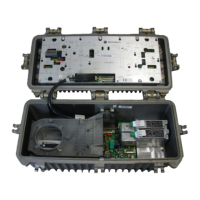Operation 5-19
SG 2000 Installation and Operation Manual
SG2-EIFPT Optical Transmitter
The SG2-EIFPT is an enhanced, isolated, Fabry-Perot return-path optical transmitter designed for
use in the SG 2000 node platform. It has a nominal optical output power of 1 mW and can be used in
conjunction with an AM-RPR, AM-OMNI-RPR/2, or other similar return path optical receiver.
Figure 5-20 illustrates the SG2-EIFPT:
Figure 5-20
SG2-EIFPT
F
A
U
L
T
O
N
LASER
CURRENT
(1 V/A)
RF
(-20 dB)
OPTICAL
POWER
(1 V/mW)
RF
INPUT
SG2000
Optical Transmitter
ASSEMBLED
IN MEX ICO
SG2-EIFPT
Table 5-7 provides information on the user-related features of the SG2-EIFPT:
Table 5-7
SG2-EIFPT features
Feature Description
Optical power test point
This test point enables monitoring of the optical output level of the
module. The nominal scale factor is 1.0 V/mW. The optical power
test point voltage is between 0.945 V and 1.055 V (optical power of
0.945 mW through 1.055 mW) when the module is enabled under
normal operating conditions. Note that the optical power test point
does not track changes in optical power due to the laser tracking
error.
Laser current test point
This test point enables monitoring of the current drawn by the laser
diode. The nominal scale factor is 1.0 V/A. The laser current test
point voltage is between 4 mV through 90 mV (laser current of
4 mA through 90 mA) when the module is enabled under normal
operating conditions. The laser current is expected to vary widely
with changes in temperature, but should always remain between
the limits.
Transmitter enable
A green LED that provides visual indication of the transmitter’s
enable status.
Fault indicator
A single red LED that lights when the hybrid current is outside the
normal operating range, the laser output power is below normal
limits, or the laser current is above normal limits. Because the laser
output requires a short period of time to stabilize, it is acceptable
for the fault indicator to illuminate during the stabilization interval
(approximately 2 seconds). Note that the module must be enabled
for the fault indicator to function.

